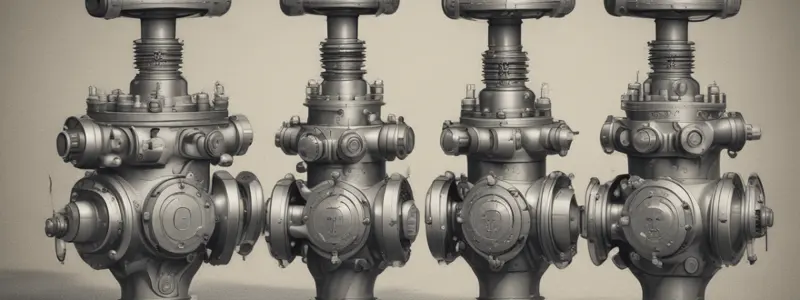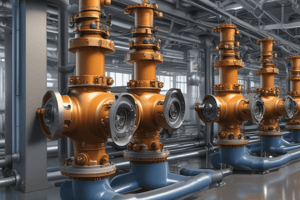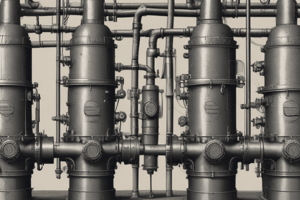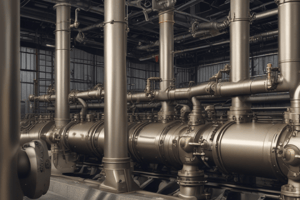Podcast
Questions and Answers
All pressure relief valves have different operating characteristics and applications.
All pressure relief valves have different operating characteristics and applications.
False (B)
ASME PTC-25 Pressure Relief Devices defines 5 different types of pressure relief valves.
ASME PTC-25 Pressure Relief Devices defines 5 different types of pressure relief valves.
False (B)
Relief Valves are characterized by rapid opening and are normally used to relieve incompressible fluids.
Relief Valves are characterized by rapid opening and are normally used to relieve incompressible fluids.
False (B)
Safety Valves are characterized by gradual opening and are normally used to relieve compressible fluids.
Safety Valves are characterized by gradual opening and are normally used to relieve compressible fluids.
Pressure Relief Valves can be actuated by both pressure and temperature.
Pressure Relief Valves can be actuated by both pressure and temperature.
The term 'safety valve' is used to describe all types of pressure relief valves.
The term 'safety valve' is used to describe all types of pressure relief valves.
Pressure Relief Valves automatically open to relieve pressure but do not reclose.
Pressure Relief Valves automatically open to relieve pressure but do not reclose.
ASME BPVC I, Part PG-73.1.4 states that the definitions relating to pressure relief devices are defined by ASME PTC-25.
ASME BPVC I, Part PG-73.1.4 states that the definitions relating to pressure relief devices are defined by ASME PTC-25.
The term 'pressure relief valve' only refers to devices that reclose after relieving excess pressure.
The term 'pressure relief valve' only refers to devices that reclose after relieving excess pressure.
A boiler with more than 500 ft2 of bare tube water-heating surface must have at least three pressure relief valves.
A boiler with more than 500 ft2 of bare tube water-heating surface must have at least three pressure relief valves.
The pressure relief valve capacity for each boiler should discharge all the steam generated by the boiler without allowing the pressure to rise more than 10% above the highest pressure.
The pressure relief valve capacity for each boiler should discharge all the steam generated by the boiler without allowing the pressure to rise more than 10% above the highest pressure.
The set pressure of a superheater safety valve must take into consideration that the steam pressure will increase as it flows from the steam drum to the superheater outlet.
The set pressure of a superheater safety valve must take into consideration that the steam pressure will increase as it flows from the steam drum to the superheater outlet.
To increase the popping pressure, the jam nut on the adjusting nut must be tightened.
To increase the popping pressure, the jam nut on the adjusting nut must be tightened.
ASME BPVC I, Part PG-71 covers the design and material selection of safety valves.
ASME BPVC I, Part PG-71 covers the design and material selection of safety valves.
Safety valves are commonly found on steam boilers, steam lines, and compressed air vessels, but not on refrigerant receivers.
Safety valves are commonly found on steam boilers, steam lines, and compressed air vessels, but not on refrigerant receivers.
Cast iron safety valves are used for high-pressure and high-temperature applications.
Cast iron safety valves are used for high-pressure and high-temperature applications.
Safety valves can be mounted in any position on the boiler.
Safety valves can be mounted in any position on the boiler.
ASME BPVC Section I, Part PG-68 requires all superheater and reheater pressure relief valves to be constructed of cast iron.
ASME BPVC Section I, Part PG-68 requires all superheater and reheater pressure relief valves to be constructed of cast iron.
A discharge pipe, if used, should be rigidly connected to the valve.
A discharge pipe, if used, should be rigidly connected to the valve.
Figure 7 shows a cast-iron safety valve suitable for boilers operating at pressures up to 500 kPa.
Figure 7 shows a cast-iron safety valve suitable for boilers operating at pressures up to 500 kPa.
A safety valve is held open with a spring that holds a valve disc tightly against a seat.
A safety valve is held open with a spring that holds a valve disc tightly against a seat.
The try lever on a safety valve can be used to manually lift the valve at any boiler pressure.
The try lever on a safety valve can be used to manually lift the valve at any boiler pressure.
ASME BPVC I covers the testing and adjustments of safety valves.
ASME BPVC I covers the testing and adjustments of safety valves.
An authorized inspector passes a wire through hole 'X' and attaches a seal to prevent access to the adjusting nut.
An authorized inspector passes a wire through hole 'X' and attaches a seal to prevent access to the adjusting nut.
The huddling chamber escape ports are located at the top of the valve disc.
The huddling chamber escape ports are located at the top of the valve disc.
The blowdown adjusting ring can only be moved up or down to vary the size of the huddling chamber escape port opening by a certain amount.
The blowdown adjusting ring can only be moved up or down to vary the size of the huddling chamber escape port opening by a certain amount.
The safety valve disc has a skirt that forms a small compartment called the huddling chamber.
The safety valve disc has a skirt that forms a small compartment called the huddling chamber.
The valve disc is equipped with guides at the top and bottom to allow it to move horizontally.
The valve disc is equipped with guides at the top and bottom to allow it to move horizontally.
The ASME BPVC I, Part PG-72.1 states that pressure relief valves shall be designed and constructed to operate with a minimum blowdown of 1 psi or 1% of the set pressure.
The ASME BPVC I, Part PG-72.1 states that pressure relief valves shall be designed and constructed to operate with a minimum blowdown of 1 psi or 1% of the set pressure.
The PRV spring can be designed for a specific range of opening pressure, but it cannot be adjusted.
The PRV spring can be designed for a specific range of opening pressure, but it cannot be adjusted.
The locking screw is secured in place by a wire seal, installed by the valve manufacturer.
The locking screw is secured in place by a wire seal, installed by the valve manufacturer.
The boiler pressure must drop significantly for the valve to reclose when the huddling chamber escape ports are fully open.
The boiler pressure must drop significantly for the valve to reclose when the huddling chamber escape ports are fully open.
The blowdown adjusting ring can be moved without removing the locking screw.
The blowdown adjusting ring can be moved without removing the locking screw.
The safety valve is designed to open and close slowly to prevent water hammer.
The safety valve is designed to open and close slowly to prevent water hammer.
Flashcards are hidden until you start studying
Study Notes
Pressure Relief Valves
- Automatically open to relieve pressure and then automatically reclose
- Exist in many different varieties, with 11 types defined by ASME PTC-25 Pressure Relief Devices
- Each type has distinct operating characteristics and applications
Types of Pressure Relief Valves
- Pressure Relief Valve: designed to actuate on inlet static pressure and reclose after normal conditions have been restored
- Temperature and Pressure (T&P) Relief Valve: actuated by pressure at the valve inlet or by temperature at the valve inlet
- Relief Valve: characterized by gradual opening, generally proportional to the increase in pressure, used for incompressible fluids
- Safety Relief Valve: characterized by rapid opening or gradual opening, used for compressible or incompressible fluids
- Safety Valve: characterized by rapid opening, used to relieve compressible fluids
Requirements for Boilers
- Each boiler shall have at least one pressure relief valve
- Boilers with more than 500 ft2 of bare tube water-heating surface or electric boilers with a power input more than 1100 kW shall have two or more pressure relief valves
- Pressure relief valve capacity shall be such that the valve will discharge all the steam that can be generated by the boiler without allowing the pressure to rise more than 6% above the highest pressure at which any valve is set
Superheater and Reheater PRVs
- Pressure drop upstream of each pressure relief valve shall be considered in the determination of set pressure and relieving capacity of that valve
- Superheater PRV must open before the drum PRVs do and close after the drum PRVs
Safety Valve Construction
- Made of cast iron, steel, alloy steel, or bronze
- Used for relieving compressible fluids, commonly found on steam boilers, steam lines, compressed air vessels, and refrigerant receivers
- Consists of a spring that holds a valve disc tightly against a seat, which opens when the steam pressure reaches the set point pressure
Safety Valve Operation
- Valve disc has a lip (skirt) that forms a huddling chamber, which fills with steam when the valve starts to open, increasing the effective area of the disc
- When the valve lifts, the pressure of the steam acts on this increased disc area, resulting in a greater force against the compression spring, causing the valve to pop wide open
- The valve will remain open until the pressure drops to below the popping pressure
Blowdown
- Defined as the difference between the actual popping pressure of a pressure relief valve and the actual reseating pressure, expressed as a percentage of set pressure or in pressure units
- Minimum blowdown of 2 psi (15 kPa) or 2% of the set pressure is required by ASME BPVC I, Part PG-72.1
Installation of PRVs
- Safety valves mounted on the drum, superheater, reheater inlet and outlet headers must be placed in an upright position with the spindle vertical
- Must be connected to the boiler independent of any other steam connection, and located as close as possible to the boiler without any unnecessary intervening pipe or fitting
Studying That Suits You
Use AI to generate personalized quizzes and flashcards to suit your learning preferences.




